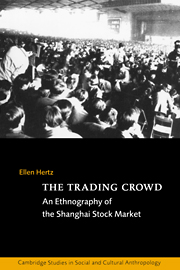Introduction: Ways and means
Published online by Cambridge University Press: 05 June 2012
Summary
Ways
This is an anthropological study of the Shanghai stock market based on ten months of ethnographic fieldwork in Shanghai, People's Republic of China, during the year 1992. It documents a particular moment in the history of China's experiments with economic reforms, the moment when this symbolically charged “capitalist mechanism” was first officially promoted on a large scale in one of China's most important cities. It tells the “moral” of the stock market as it evolved over the course of that year, the ways in which its main characters and important events were constructed into a political–moral storyline by Shanghainese investors and government regulators alike.
Comparing notes with colleagues, orally and in print (Golde 1986 [1970], Rabinow 1977, van Maanen 1988), it seems to me that this project has been both unusually easy and unusually difficult. What made it easy was the tremendous interest the Shanghainese themselves showed in my topic. The months of my fieldwork, from February to December of 1992, coincided with the Chinese government's first unambiguous signals in favor of popular participation in the stock market. The result was a movement of “stock fever” (gupiao re) of an intensity which China had not experienced since the Republican era. For the majority of people I talked with during that time, it seemed normal, and even desirable, that this historic moment be documented by foreign scholars. From the moment I set foot in Shanghai until my last day there, people from all walks of life wanted to talk to me about the market.
- Type
- Chapter
- Information
- The Trading CrowdAn Ethnography of the Shanghai Stock Market, pp. 1 - 28Publisher: Cambridge University PressPrint publication year: 1998

